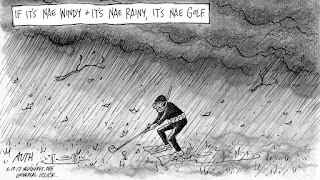Rain has been falling throughout the state for the past few days, everywhere that is except where we live. The storms have gone around us, I'm not sure if that is called being lucky or not but that's the way things are. Skunkpuppy and I sat outside for a while this morning as is normal for us. She is continually looking over her shoulder making sure I haven't retreated to the house. I managed to video two Canadian Honkers on my neighbor's dock, they were in the wind and light drizzle. The dog was not interested in them which is odd for her, normally on her morning patrol every bird, squirrel, rabbit, and turkey is rushed away by her. I am of the opinion one of the geese took issue with being chased and had a head to head with her. None the less she's not messing with them any longer, as far as I'm concerned it's good.
Southern California received a considerable amount of rainfall as evidenced by the news reports and in the local paper. The Los Angelos river is full to the point of overcoming the walkways on each bank, normally it has very little water flowing through it.
Northern California has received rain as well, flooding has been reported in many areas around San Francisco. Further north in Butte County substantial rainfall has been reported also, as we recall the Campfire started in Butte County.
Tornado warnings were issued last night, one in Chowchilla in the Central Valley, and another North of Sacramento, these are rare events. Last week one touched down within 100 yards of my daughters home in Clovis. They have several acres which serve as the company lot for their tree trimming business. High winds and heavy seas as we would refer to nasty weather while out at sea.
Rain is forecast to continue for the next few days, we may still feel the impact as of now we are facing 2 mph winds and overcast skies. There is some snow on the Diablo Range, it's fairly commonplace usually it does not remain long. Flooding is not a threat here but sandbags are still being made available to us, so far they are needed throughout the state but not here.
Sandbags are heavy, some are really heavy, but not heavy enough for massive flows of water. One cubic yard of water weighs 1700 lbs (2000 k) six inches of flowing water is able to knock an adult over. To prevent the water rising to a space invading level that must be kept dry, most local governments will supply the bags and the sand, we supply the labor fill the bags. A mixture of 1:10 cement to sand is the recommended mix, however in a pinch, any soil will serve. Shovel the mixture into a burlap bag (it won't work with plastic bags) set the bags in place then wet with water, after drying it will form a semi-permanent barrier. Preparation can begin a few weeks prior to an anticipated event, caution is advised to keep the materials and full bags dry.
Click
here for emergency sandbagging construction.
When erecting a sandbag dike the sewed end of the 1/2 filled burlap bag must face into the flow otherwise the sand will be washed out. Lay the first course on a level surface, be sure while setting them to flatten the tops and sides. The first course of bags must be at a minimum 3 deep, the second 2 deep and the top course 1 bag deep. The height of the dike determines the depth of the first course of bags. A pyramid structure is very stable and will resist the pressure of the water when constructed properly. The completed sandbag dike should not be expected to direct flow higher than 2 feet, at that height, it will act as a dam if constructed properly. Set the bag, fold the open top under the body, aim the sewed end towards the flow, stack in a pyramid and your sandbag dike will work. However left in place the burlap will deteriorate over time, in most cases just a few weeks.
 |
| Proper construction aids strength. |
Don't use bales of straw or hay as a dike, they will merely wash away and water will permeate them. A temporary dike is meant to direct water, not totally dam it up, although it will work as a dam for a while. If a longer lasting dike is needed due to recurring flooding a more durable berm should be constructed. The permanent structure can be an elaborate cement wall or a hand dug ditch. The intent is to keep the water from invading the space you want to protect. Keeping in mind the basic intent and which way the water flows will able us to construct a good solid temporary or permanent flood control dike.
 |
| Well, this is a start, only 1,000 left to go. |
It is advisable once again as I normally do when talking about flood water, not to use it for anything, it is polluted and may be toxic. During a flood, the water flows through farm fields, roads, golf courses and all areas lower than where the water originates. Often sewer lines, sumps, and septic tanks back up and everything there rise to the top. If you come in contact with flood water, wash affected areas with hot soap and water. Wear rubber boots and rubber gloves, lift properly and dress warmly.
Thanks for reading and sharing, pay attention to the weather and if possible prepare early and practice building a dike. Thanks again.
Jacques Lebec Natural Self-Reliance
































